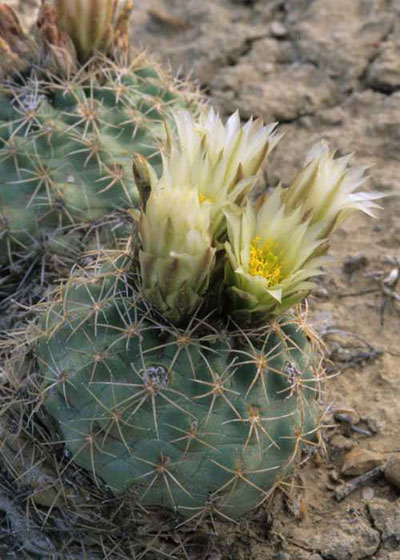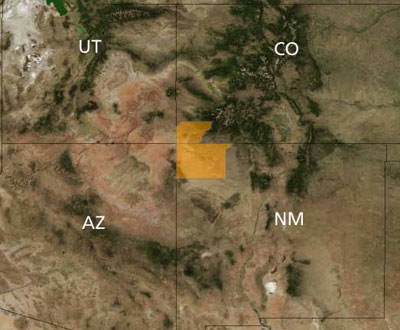Habitat and Ecology

© Robert Sivinski
At the time of its listing as a federal threatened species, Mesa Verde cactus (Sclerocactus mesae-verdae) grew in a few isolated populations in southwestern Colorado and northwestern New Mexico. The known populations are restricted to the Mancos and Fruitland Shale formations at the eastern edge of the Navajoan Desert. These formations erode to form badlands with soils that are highly alkaline, gypsum-rich, and prone to swelling upon exposure to water. Mesa Verde cactus usually grows on the tops or the slopes of these sparsely vegetated badlands. These habitats are at 1980 to 1600 m (5250 to 6500 ft) in elevation and receive 8 to 20 cm (3 to 8 in) of annual precipitation. Biologists estimate that a total of 5,000-10,000 plants exist.
Description
Mesa Verde cactus usually has one spherical stem that is pale green in color, but it can form clusters of up to 15 stems. The stems are only 3.8 to 7.6 cm (1.5 to 3 in) tall, and they retract into the soil during drought. The stems have eight to eleven radial spines that are straw-colored and a quarterinch to a half-inch long. Usually, there is no central spine.
In late April to early May, a cream- to yellow-colored flower blooms on the top of the stem. Each flower lasts two to three days and may be pollinated by a sweat bee or other unknown types of pollinators. The resulting fruit is initially green, but becomes tan with age. In mid-June, the fruit splits, allowing the black seeds to fall to the base of the plant. The seeds often germinate adjacent to parent plant, but the seedling success rate is low.
Conservation Status and Threats

USFWS
The U.S. Fish and Wildlife Service has listed Mesa Verde cactus as a threatened species since October 30, 1979. Arizona and New Mexico both list the cactus as imperiled.
Mesa Verde cactus is primarily threatened by plant collectors, but it is also threatened by destruction or modification of its habitat, by off-road vehicles, coal mining, oil and gas exploration and production, commercial and residential expansion, livestock trampling, and the construction of powerlines. In 2003, Mesa Verde cactus suffered massive die-offs after a drought and subsequent insect infestation.
Related species
Mesa Verde cactus can be confused with Wright’s fishhook cactus (Sclerocactus wrightiae). Both grow on gypsumrich soils, and their populations are separated from each other by about 140 miles. However, Wright’s fishhook cactus has four to six central spines, while Mesa Verde cactus usually has none; and Wright’s fishhook cactus has fragrant flowers.
References
Heil, D. K., and J. M. Porter. 1993. Sclerocactus mesaeverdae. Pages 198, 201, and 203 in Flora of North America. Volume 4. NewYork, NY, and Oxford, UK.
NatureServe. 2009. Sclerocactus mesae-verdae. NatureServe explorer: An online encyclopedia of life. Version 7.1. NatureServe, Arlington, VA. Available at http://www.natureserve.org/explorer/ (accessed 9 June 2010).
U.S. Fish and Wildlife Service. 1984. Mesa Verde cactus (Sclerocactus mesae-verdae) recovery plan. Available at http://www.fws.gov/ecos/ajax/docs/recovery_ plan/840330a.pdf (accessed 9 June 2010).
Prepared by Kelly Reeves, Southern Colorado Plateau Network Inventory and Monitoring Program, 2010.
Last updated: October 3, 2016
